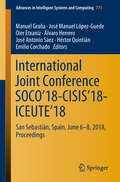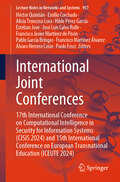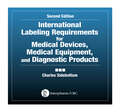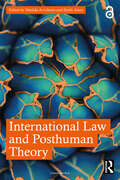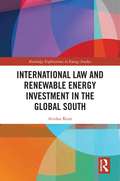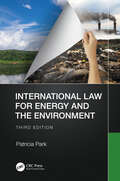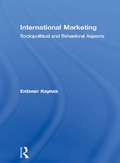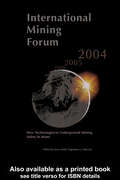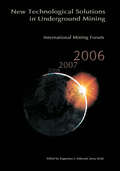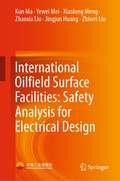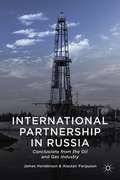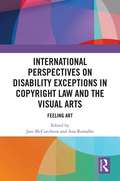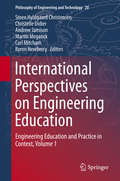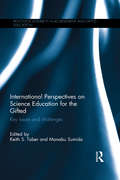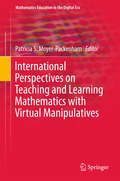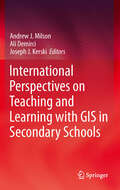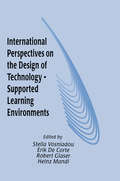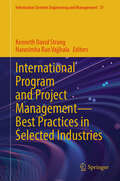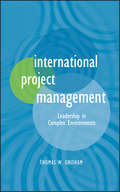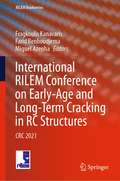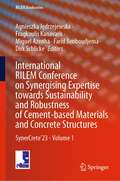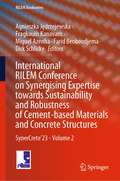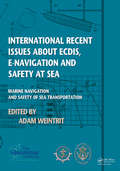- Table View
- List View
International Joint Conference SOCO’18-CISIS’18-ICEUTE’18: San Sebastián, Spain, June 6-8, 2018 Proceedings (Advances in Intelligent Systems and Computing #771)
by Manuel Graña Álvaro Herrero Héctor Quintián Emilio Corchado José Manuel López-Guede Oier Etxaniz José Antonio SáezThis book includes papers presented at SOCO 2018, CISIS 2018 and ICEUTE 2018, all held in the beautiful and historic city of San Sebastian (Spain), in June 2018. Soft computing represents a collection or set of computational techniques in machine learning, computer science and some engineering disciplines, which investigate, simulate, and analyze highly complex issues and phenomena. After a rigorous peer-review process, the 13th SOCO 2018 International Program Committee selected 41 papers, with a special emphasis on optimization, modeling and control using soft computing techniques and soft computing applications in the field of industrial and environmental enterprises. The aim of the 11th CISIS 2018 conference was to offer a meeting opportunity for academic and industry researchers from the vast areas of computational intelligence, information security, and data mining. The need for intelligent, flexible behaviour by large, complex systems, especially in mission-critical domains, was the catalyst for the overall event.Eight of the papers included in the book were selected by the CISIS 2018 International Program Committee. The International Program Committee of ICEUTE 2018 selected 11 papers for inclusion in these conference proceedings.
International Joint Conferences: 17th International Conference on Computational Intelligence in Security for Information Systems (CISIS 2024) and 15th International Conference on European Transnational Education (ICEUTE 2024) (Lecture Notes in Networks and Systems #957)
by Héctor Quintián Emilio Corchado Francisco Javier Martínez de Pisón Hilde Pérez García Francisco Martínez Álvarez Alicia Troncoso Lora Pablo García Bringas Esteban Jove José Luis Calvo Rolle Paolo Fosci Álvaro Herrero CosíoThis volume of Lecture Notes in Networks and Systems contains accepted papers presented at the 17th International Conference on Computational Intelligence in Security for Information Systems (CISIS 2024) and the 15th International Conference on EUropean Transnational Education (ICEUTE 2024), which were held in the beautiful city of Salamanca, Spain, in October 2024. The aim of the CISIS 2024 conference is to offer a meeting opportunity for academic and industry-related researchers belonging to the various vast communities of Computational Intelligence, Information Security, and Data Mining. The need for intelligent, flexible behavior by large, complex systems, especially in mission-critical domains, is intended to be the catalyst and the aggregation stimulus for the overall event. After peer review, the CISIS 2024 International Program Committee selected 24 papers for publication in these conference proceedings. In this edition, one special session was organized: Artificial Intelligence for Protecting the Internet of Things. The aim of ICEUTE 2024 conference is to offer a stimulating and fruitful meeting point for people working on transnational education within Europe. It provides an exciting forum for presenting and discussing the latest works and advances in transnational education within European countries. In the case of ICEUTE 2024, the International Program Committee selected nine papers, which are also published in these conference proceedings. The selection of papers was extremely rigorous to maintain the high quality of the conferences. We deeply appreciate the hard work and dedication of the members of the Program Committees during the reviewing process. Their contributions are integral to the creation of a high-standard conference; the CISIS and ICEUTE conferences would not exist without their help.
International Labeling Requirements for Medical Devices, Medical Equipment and Diagnostic Products
by Charles SidebottomCompletely revised, this second edition provides the practical, hands-on labeling information needed to secure rapid regulatory approval, gain marketplace acceptance, and assure user comprehension. A complete guide to all aspects of advertising, labeling, and packaging, it explains the relevant laws, regulations, and requirements in major markets w
International Law and Posthuman Theory
by Emily Jones Matilda ArvidssonAssembling a series of voices from across the field, this book demonstrates how posthuman theory can be employed to better understand and tackle some of the challenges faced by contemporary international law.With the vast environmental devastation being caused by climate change, the increasing use of artificial intelligence by international legal actors and the need for international law to face up to its colonial past, international law needs to change. But in regulating and preserving a stable global order in which states act as its main subjects, the traditional sources of international law – international legal statutes, customary international law, historical precedents and general principles of law – create a framework that slows down its capacity to act on contemporary challenges, and to imagine futures yet to come. In response, this collection maintains that posthuman theory can be used to better address the challenges faced by contemporary international law. Covering a wide array of contemporary topics – including environmental law, the law of the sea, colonialism, human rights, conflict and the impact of science and technology – it is the first book to bring new and emerging research on posthuman theory and international law together into one volume.This book’s posthuman engagement with central international legal debates, prefaced by the leading scholar in the field of posthuman theory, provides a perfect resource for students and scholars in international law, as well as critical and socio-legal theorists and others with interests in posthuman thought, technology, colonialism and ecology.Chapters 1, 9 and 11 of this book is freely available as a downloadable Open Access PDF at http://www.taylorfrancis.com under a Creative Commons Attribution-Non Commercial-No Derivatives (CC-BY-NC-ND) 4.0 license.
International Law and Renewable Energy Investment in the Global South (Routledge Explorations in Energy Studies)
by Avidan KentThis book will discuss the legal tools offered by international law that can support foreign direct investment (FDI) in the renewable energy sector in the Global South. Promoting and increasing investment in the renewable energy sector is crucial for limiting global temperature rise to 1.5°C and addressing energy poverty in the Global South. In this volume, Kent explores the various home-country measures (HCMs) offered by international law that support FDI in the renewable energy sector. This book provides a bird’s eye evaluation of HCMs from fields such as trade law, investment law, environmental law, development law and more. It reveals that while international law indeed offers many legal tools to support investors’ needs, the current legal framework is fragmented; most legal instruments were designed in isolation and the potential for mutually-supportive, synergetic policies has been explored only to a limited extent. This fragmented reality is in contradiction to the notion of Policy Coherence for Development, which is increasingly gaining support in leading institutions in Europe and elsewhere. This book will provide recommendations on the manner in which HCMs can be connected in order to maximise their potential and boost investment in renewable energies in the developing world. International Law and Renewable Energy Investment in the Global South will be of great interest to scholars, students, and practitioners of international law, energy studies, development studies and IR more broadly.
International Law for Energy and the Environment
by Patricia ParkThis revised edition of Energy Law and the Environment considers how international and national legislation now requires the energy sector to focus more on sustainability and the circular economy in response to new policies at both international and national levels. It explores how environmental law engages with multinational companies regarding energy sources, ownership of those resources, and state sovereignty. Written for all the players in the energy sector, lawyers and non-lawyers alike, this third edition considers the issues of energy sector regulation related to economics and protection of intellectual property associated with the development of technologies for mitigating environmentally damaging emissions. It has been updated throughout and adds new and fully revised chapters on subjects, including climate change, human rights, renewable energy, and energy law in China. Features: Updated throughout and adds new and fully revised chapters Focuses on the global trends and mandates towards environmental sustainability Examines the latest international legislation involving climate change Includes the coverage of oil and gas industries, as well as nuclear and renewable energy
International Marketing: Sociopolitical and Behavioral Aspects
by Erdener KaynakSocial, economic, political, business, and cultural environmental factors affect the international marketing operation and performance of international firms. This highly insightful volume focuses on four of the most significant forces with which companies must deal on an international level--macro international marketing issues, sociopolitical int
International Mining Forum 2004, New Technologies in Underground Mining, Safety in Mines: Proceedings of the Fifth International Mining Forum 2004, Cracow - Szczyrk - Wieliczka, Poland, 24-29 February 2004
by Jerzy Kicki Eugeniusz J. SobczykThis book comprises technical papers that were presented at the International Mining Forum 2004. This event aims to bring together scientists and engineers in mining, rock mechanics, and computer engineering, with a view to explore and discuss international developments in the field. The book is addressed to researchers and professionals who work i
International Mining Forum 2006, New Technological Solutions in Underground Mining: Proceedings of the 7th International Mining Forum, Cracow - Szczyrk - Wieliczka, Poland, February 2006
by Jerzy Kicki Eugeniusz J. SobczykThe International Mining Forum is a recurring event, hosted by the University of Science and Technology in Cracow, Poland, bringing together an international group of scientists, including those working in rock mechanics and computer engineering as well as mining engineers. The topics are wide-ranging, including papers on remote sensing to assess p
International Oilfield Surface Facilities: Safety Analysis for Electrical Design
by Kun Ma Yewei Mei Xiaolong Meng Zhaoxia Liu Jingjun Huang Zhiwei LiuThis book mainly introduces an essential safety concept and procedure for electrical engineering in oil and gas field. It begins by providing broad guidelines for performing electrical safety and operability review (ELSOR), giving reader a general overview of the field. It subsequently verifies electrical distribution, overhead line and hazardous area classification safety analysis together with comparison of different international codes and standards with China national codes, to interpret different safety concepts from different countries for electrical engineering in oil and gas field. This unique and complete co-design safety analysis will greatly benefit international electrical engineers and operators of oil and gas fields. This book is with vivid flow chart, accurate table expressing the analysis logic method and exact illustrations of code and standard of different country and area. This book stresses the electrical design safety for surface facilities of oil and gas oil field and will benefit to engineer who works with oil and gas field surface facilities engineering.
International Partnership in Russia
by Et Al. James HendersonInternational Partnership in Russia provides a unique insight into the joint ventures formed by international oil companies in Russia during the post-Soviet era. It outlines the highs and lows in their fortunes and analyses the reasons for their successes and failures.
International Perspectives on Disability Exceptions in Copyright Law and the Visual Arts: Feeling Art
by Jani McCutcheon and Ana RamalhoThis book provides an overview of disability exceptions to copyright infringement and the international and human rights legal framework for disability rights and exceptions. The focus is on those exceptions as they apply to visual art, while the book presents a comprehensive study of copyright’s disability exceptions per se and the international and human rights law framework in which they are situated. 3D printing now allows people with a visual impairment to experience 3D reproductions of paintings, drawings and photographs through touch. At the same time, the uncertain application of existing disability exceptions to these reproductions may generate concerns about legal risk, hampering sensory art projects and reducing inclusivity and equity in cultural engagement by people with a visual impairment. The work adopts an interdisciplinary approach, with contributions from diverse stakeholders, including persons with disabilities, cultural institutions and the 3D printing industry. The book sketches the scene relating to sensory art projects. Experts in intellectual property, human rights, disability and art law then critically analyse the current legal landscape relating to disability access to works of visual art at both international and regional levels, as well as across a broad representative sample of national jurisdictions, and identify where legal reform is required. This comparative analysis of the laws aims to better inform stakeholders of the applicable legal landscape, the legal risks and opportunities associated with sensory art and the opportunities for reform and best practice guidelines, with the overarching goal of facilitating international harmonisation of the law and enhanced inclusivity.
International Perspectives on Engineering Education
by Carl Mitcham Andrew Jamison Steen Hyldgaard Christensen Christelle Didier Martin Meganck Byron NewberryThis inclusive cross-cultural study rethinks the nexus between engineering education and context. In so doing the book offers a reflection on contextual boundaries with an overall boundary crossing ambition and juxtaposes important cases of critical participation within engineering education with sophisticated scholarly reflection on both opportunities and discontents. Whether and in what way engineering education is or ought to be contextualized or de-contextualized is an object of heated debate among engineering educators. The uniqueness of this study is that this debate is given comprehensive coverage - presenting both instrumentally inclined as well as radical positions on transforming engineering education. In contextualizing engineering education, this book offers diverse commentary from a range of disciplinary, meta- and interdisciplinary perspectives on how cultural, professional, institutional and educational systems contexts shape histories, structural dynamics, ideologies and challenges as well as new pathways in engineering education. Topics addressed include examining engineering education in countries ranging from India to America, to racial and gender equity in engineering education and incorporating social awareness into the area. Using context as "bridge" this book confronts engineering education head on. Contending engineering ideologies and corresponding views on context are juxtaposed with contending discourses of reform. The uniqueness of the book is that it brings together scholars from the humanities, the social sciences and engineering from Europe - both East and West - with the United States, China, Brazil, India and Australia.
International Perspectives on Publishing Platforms: Image, Object, Text (Digital Research in the Arts and Humanities)
by Meghan ForbesWith large-scale scholarly projects dedicated to digitizing print-based magazines and a concurrent turn towards digital mapping and data visualization, periodicals that were once accessible only in the archive now have the capacity to reach a wider audience, and make visible previously overlooked networks and connections enacted within and across the magazines. International Perspectives on Publishing Platforms: Image, Object, Text offers a unique contribution to the field of periodical studies, while also broadening the scope of purview to consider related content with regards to other relevant printed matter and cultural products, as well as digital archiving strategies. Including interdisciplinary contributions from academics around the world, the volume presents a wide range of approaches to periodicals and printed matter from Africa, Asia, Europe, the Middle East, Latin America, and the Caribbean. Questions of material print culture and the digital realm are considered both via theoretical and more empirical approaches. As a whole, the book considers the pluralism of perspectives that the study of periodicals and printed matter contribute to our historical understanding of various political and social issues, and also devotes attention to the ways in which digital archiving projects can be instrumentalized as a strategy for filling in gaps in the historical record. International Perspectives on Publishing Platforms should be of great interest to researchers, academics and postgraduates engaged in the study of periodicals, publishing, book history, world literature, digital humanities, media, visual and material culture.
International Perspectives on Science Education for the Gifted: Key issues and challenges (Routledge Research in Achievement and Gifted Education)
by Manabu Sumida Keith S TaberIn the spirit of encouraging international dialogue between researchers and practitioners, often working within isolated traditions, this book discusses perspectives on science education for the gifted informed by up-to-date research findings from a number of related fields. The book reviews philosophy, culture and programmes in science education for the gifted in diverse national contexts, and includes scholarly reviews of significant perspectives and up-to-date research methods and findings. The book is written in a straightforward style for students studying international perspective modules on undergraduate, but especially masters and doctoral degrees in Science Education and Gifted Education. Gifted education has come to be regarded as a key national programme in many countries, and gifted education in science disciplines is now of major importance to economic and technological development. Despite these national initiatives and developments, there are very few discussions on gifted education in science from international perspectives. This will be a valued addition to the scholarship in this emergent field.
International Perspectives on Teaching and Learning Mathematics with Virtual Manipulatives
by Patricia S. Moyer-PackenhamThis book explores terminology, frameworks, and research being conducted worldwide on virtual manipulatives. It brings together international authors who provide their perspectives on virtual manipulatives in research and teaching. By defining terminology, explaining conceptual and theoretical frameworks, and reporting research, the authors provide a comprehensive foundation on the study and use of virtual manipulatives for mathematics teaching and learning. This foundation provides a common way for researchers to communicate about virtual manipulatives and build on the major works that have been conducted on this topic. By discussing these big ideas, the book advances knowledge for future research on virtual manipulatives as these dynamic tools move from computer platforms to hand-held, touch-screen, and augmented platforms.
International Perspectives on Teaching and Learning with GIS in Secondary Schools
by Joseph J. Kerski Andrew J. Milson Ali DemirciThis, the first publication to collate a broad international perspective on the pedagogical value of GIS technology in classrooms, offers an unprecedented range of expert views on the subject. Geographic Information Systems (GISs) are now ubiquitous and relatively inexpensive. They have revolutionized the way people explore and understand the world around them. The capability they confer allows us to capture, manage, analyze, and display geographic data in ways that were undreamt of a generation ago. GIS has enabled users to make decisions and solve problems as diverse as designing bus routes, locating new businesses, responding to emergencies, and researching climate change. GIS is also having a major impact in the classroom. Students and teachers around the world are using this significant emerging technology in the secondary school classroom to study social and scientific concepts and processes, to broaden their technical skills, and to engage in problem solving and decision making about local and global issues. International Perspectives on Teaching and Learning with GIS in Secondary Schools brings together authors from 34 countries who profile the current status of GIS in secondary school teaching and learning in their country. Each chapter includes a summary of the country's educational context, a case study illustrating how GIS is used in secondary schooling, and an assessment of the opportunities and challenges in teaching and learning with GIS now and in the future. The book demonstrates that GIS is not only a technological tool to be used in the classroom, but also a catalyst for motivation, encouragement, and cooperation in understanding and solving global problems. The most up to date and extensive survey of GIS in the secondary education landscape, covering both principles and practice. Professor David Maguire, Pro-Vice-Chancellor, Birmingham City University, UK International Perspectives on Teaching and Learning With GIS in Secondary Schools is a highly relevant, critically important, reflective contribution to the literature, providing strong arguments supporting the inclusion for spatial studies for all in secondary school education. Karl Donert, President, EUROGEO This is an invaluable and inspirational examination of innovation in geospatial technologies in secondary schools around the world. Each chapter contains practical models for how to integrate powerful tools for spatial analysis into a range of subjects. It will be useful to classroom teachers and administrators seeking pathways to implementation and teacher educators considering how to prepare the next generation to use geospatial technologies. Sarah Witham Bednarz, Department of Geography, Texas A&M University, College Station, TX, USA
International Perspectives on the Design of Technology-supported Learning Environments
by Robert Glaser Stella Vosniadou Erik De Corte Heinz MandlIn recent years, the use of technology for the purposes of improving and enriching traditional instructional practices has received a great deal of attention. However, few works have explicitly examined cognitive, psychological, and educational principles on which technology-supported learning environments are based. This volume attempts to cover the need for a thorough theoretical analysis and discussion of the principles of system design that underlie the construction of technology-enhanced learning environments. It presents examples of technology-supported learning environments that cover a broad range of content domains, from the physical sciences and mathematics to the teaching of language and literacy. The emphasis in this book is not on the design of educational software but on the design of learning environments. A great deal of research on learning and instruction has recently moved out of the laboratory into the design of applications in instructional settings. By designing technology-supported learning environments instructional scientists attempt to better understand the theories and principles that are explicit in their theories of learning. The contributors to this volume examine how factors such as social interaction, the creation of meaningful activities, the use of multiple perspectives, and the construction of concrete representations influence the acquisition of new information and transfer.
International Program and Project Management — Best Practices in Selected Industries (Information Systems Engineering and Management #31)
by Narasimha Rao Vajjhala Kenneth David StrangThis book examines the latest best practices in international program and project management, offering invaluable insights across various industries. Edited by renowned experts, this book brings together a diverse range of case studies and research from leading scholars and practitioners worldwide. From a detailed macro-environmental analysis of contemporary project management to exploring the complexities of AI project management, each chapter highlights critical strategies, tools, and methodologies needed to tackle today's evolving challenges in program and project management. Topics such as ISO standards, ISO 21502, project management body of knowledge (PMBOK), risk management in high-complexity environments, stakeholder management, and agile business intelligence projects are discussed through practical case studies from industries ranging from fintech and biopharmaceuticals to public administration. This book is an essential resource for project managers, researchers, and industry professionals seeking to enhance their understanding of global project management dynamics and apply cutting-edge approaches across sectors. Chapter 7 is available open access under a Creative Commons Attribution 4.0 International License via link.springer.com.
International Project Management
by Thomas W. GrishamThe theory, practice, and example projects of international project managementA Singaporean corporation builds a manufacturing facility in Cambodia, with a Chinese partner, a Cambodian government agency, and value chain organizations in Germany, Morocco, Vietnam, and Brazil.A Russian charity operates in the Balkans and the Persian Gulf. Pharmaceuticals and food come from ten different countries, physicians are from the EU and Russia, and donations are from Central Asia and the subcontinent.A transnational organization markets through divisions in eighty-two countries. The products are designed in Italy, Sweden, and France, with customization done in each respective country.International projects involve a complex network of cultures, politics, laws, languages, and resources that goes beyond the traditional training and experience of most project managers. International Project Management examines the different dimensions and responsibilities of international projects, and outlines what a project manager must know to lead global projects successfully. It also provides guidelines and examples for the international project management processes.This book explores the professional best practices of international projects, emphasizing the importance of leadership skills and virtual teamwork to successfully navigate an international project. Along with discussions on the process groups, such as initiating, planning, execution, monitoring and controlling, and closing out, this reference is organized according to these knowledge areas:Introduction to international project managementIntegration managementHR management (Diversity & Communications)Scope managementCost and progress managementRisk managementTime managementCustomer satisfaction (Quality)Procurement managementCPE in the futureIntegrating the PMBOK Guide--Fourth Edition, and the ICB, International Project Management provides international project managers, whether experienced or beginners, with the high cross-cultural intelligence, creative communication skills, ability to establish and maintain dependable project management processes, and compelling curiosity to manage international projects successfully.
International R&D Spillovers and Institutions
by Elhanan Helpman David T. Coe Alexander W. HoffmaisterA report from the International Monetary Fund.
International RILEM Conference on Early-Age and Long-Term Cracking in RC Structures: CRC 2021 (RILEM Bookseries #31)
by Miguel Azenha Farid Benboudjema Fragkoulis KanavarisThis volume gathers the latest advances, innovations and applications in the field of crack control in concrete, as presented by leading international researchers and engineers at the International RILEM Conference on Early-age and Long-term Cracking in RC Structures (CRC 2021), held in Paris, France on April 9, 2021. It covers early-age and long-term imposed deformations in concrete, analytical formulations for calculating crack widths in concrete, numerical simulations of early-age and long-term restrained behaviour of concrete elements, experimental investigations on cracking, on-site monitoring of imposed deformations and cracking, crack control and repair, and sustainability of design and remediation. The conference demonstrated that a comprehensive approach to this problem requires the design of robust experimental techniques, the development of multiscale models and the evaluation of code-based and other analytical approaches relevant to crack control in concrete. The contributions, which were selected through a rigorous international peer-review process, share exciting ideas that will spur novel research directions and foster new multidisciplinary collaborations.
International RILEM Conference on Synergising Expertise towards Sustainability and Robustness of Cement-based Materials and Concrete Structures: SynerCrete’23 - Volume 1 (RILEM Bookseries #43)
by Miguel Azenha Farid Benboudjema Dirk Schlicke Fragkoulis Kanavaris Agnieszka JędrzejewskaThis book highlights the latest advances, innovations, and applications in cement-based materials (CBM) and concrete structures, as presented by leading international researchers and engineers at the International RILEM Conference on synergizing expertise toward sustainability and robustness of CBM and concrete structures (SynerCrete), held in Milos Island, Greece, on June 14-16, 2023. The aim of the conference was to discuss and arouse progress in research, development, and application of CBM and structural concrete through combination of expertise from distinct fields of knowledge, such as performance-based design, 3D modeling for analysis/design, building information modeling, and even robotics, while keeping focus on multiscale approaches at time and spatial levels. It covers a diverse range of topics concerning alternative concrete formulations for adaptation to climate change, performance-based and multiphysics/multiscale design and innovative testing, structural health monitoring and maintenance management, integral BIM-based planning, and resource-responsible building. The contributions, which were selected by means of a rigorous international peer-review process, present a wealth of exciting ideas that will open novel research directions and foster new multidisciplinary collaborations. The two volumes encompass more than 200 original contributions in the field.
International RILEM Conference on Synergising Expertise towards Sustainability and Robustness of Cement-based Materials and Concrete Structures: SynerCrete’23 - Volume 2 (RILEM Bookseries #44)
by Miguel Azenha Farid Benboudjema Dirk Schlicke Fragkoulis Kanavaris Agnieszka JędrzejewskaThis book highlights the latest advances, innovations, and applications in cement-based materials (CBM) and concrete structures, as presented by leading international researchers and engineers at the International RILEM Conference on synergizing expertise toward sustainability and robustness of CBM and concrete structures (SynerCrete), held in Milos Island, Greece, on June 14-16, 2023. The aim of the conference was to discuss and arouse progress in research, development, and application of CBM and structural concrete through combination of expertise from distinct fields of knowledge, such as performance-based design, 3D modeling for analysis/design, building information modeling, and even robotics, while keeping focus on multiscale approaches at time and spatial levels. It covers a diverse range of topics concerning alternative concrete formulations for adaptation to climate change, performance-based and multiphysics/multiscale design and innovative testing, structural health monitoring and maintenance management, integral BIM-based planning, and resource-responsible building. The contributions, which were selected by means of a rigorous international peer-review process, present a wealth of exciting ideas that will open novel research directions and foster new multidisciplinary collaborations. The two volumes encompass more than 200 original contributions in the field.
International Recent Issues about ECDIS, e-Navigation and Safety at Sea: Marine Navigation and Safety of Sea Transportation
by Adam WeintritThe TransNav 2011 Symposium held at the Gdynia Maritime University, Poland in June 2011 has brought together a wide range of participants from all over the world. The program has offered a variety of contributions, allowing to look at many aspects of the navigational safety from various different points of view. Topics presented and discussed at th
